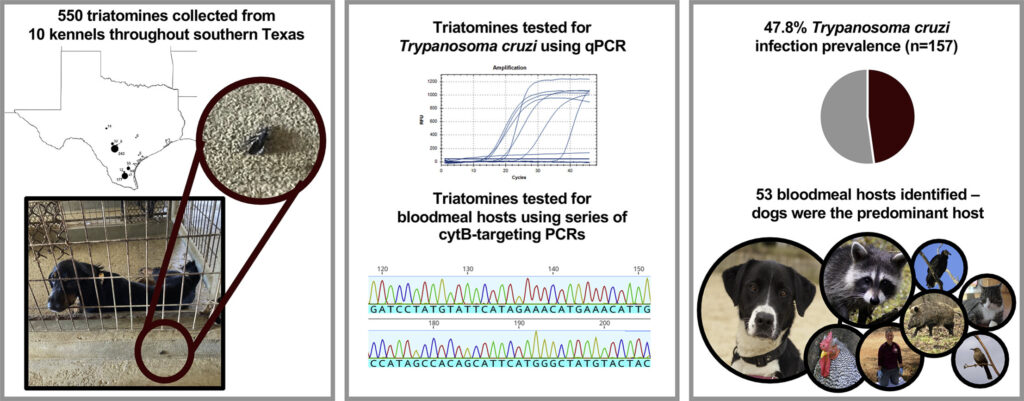Title: Abundant triatomines in Texas dog kennel environments: Triatomine collections, infection with Trypanosoma cruzi, and blood feeding hosts
Authors: R.E. Busselman, R. Curtis-Robles, A.C. Meyers, I.B. Zecca, L.D. Auckland, C.L. Hodo, D. Christopher, A.B. Saunders, and S.A. Hamer
Journal/Date of Publication: Acta Tropica, 2024
DOI: 10.1016/j.actatropica.2023.107087
Objective: Triatomines were collected across central and south Texas to identify their primary bloodmeal hosts, T. cruzi status, and the T. cruzi discrete typing units (DTUs) present.
Type of Study: Prospective
Conclusions:
- Triatomine insects are common in Texas dog kennels, with high infection rates of T. cruzi.
- Dogs are the primary blood meal host, indicating a significant risk of Chagas disease transmission in kennels.
- T. cruzi was found with multiple DTUs, mainly TcI and TcIV.
- Scent detection dogs were effective in identifying cryptic triatomine habitats.
Clinical application:
- Risk Assessment: Dog kennels, particularly those with outdoor exposure, are high-risk environments for Chagas disease.
- Detection and Surveillance: Using scent detection dogs can enhance triatomine detection in difficult-to-reach areas.
- Vector Control: Dogs in high-risk areas may benefit from insecticide treatments to reduce triatomine bites.
- Disease Prevention: Preventative measures should focus on reducing kennel exposure to triatomines, including structural modifications and pesticide application.
- Host Management: Since dogs are primary hosts, vector control strategies should prioritize interventions that limit dog-triatomine interactions.

Panel 1: 550 triatomines collected from 10 kennels throughout southern Texas
Panel 2: Triatomines tested for Trypanosoma cruzi using qPCR; Triatomines tested for bloodmeal hosts using series of cytB-targeting PCRs
Panel 3: 47.8% Trypanosoma cruzi infection prevalence (n=157); 53 bloodmeal hosts identified – dogs were the predominant host
